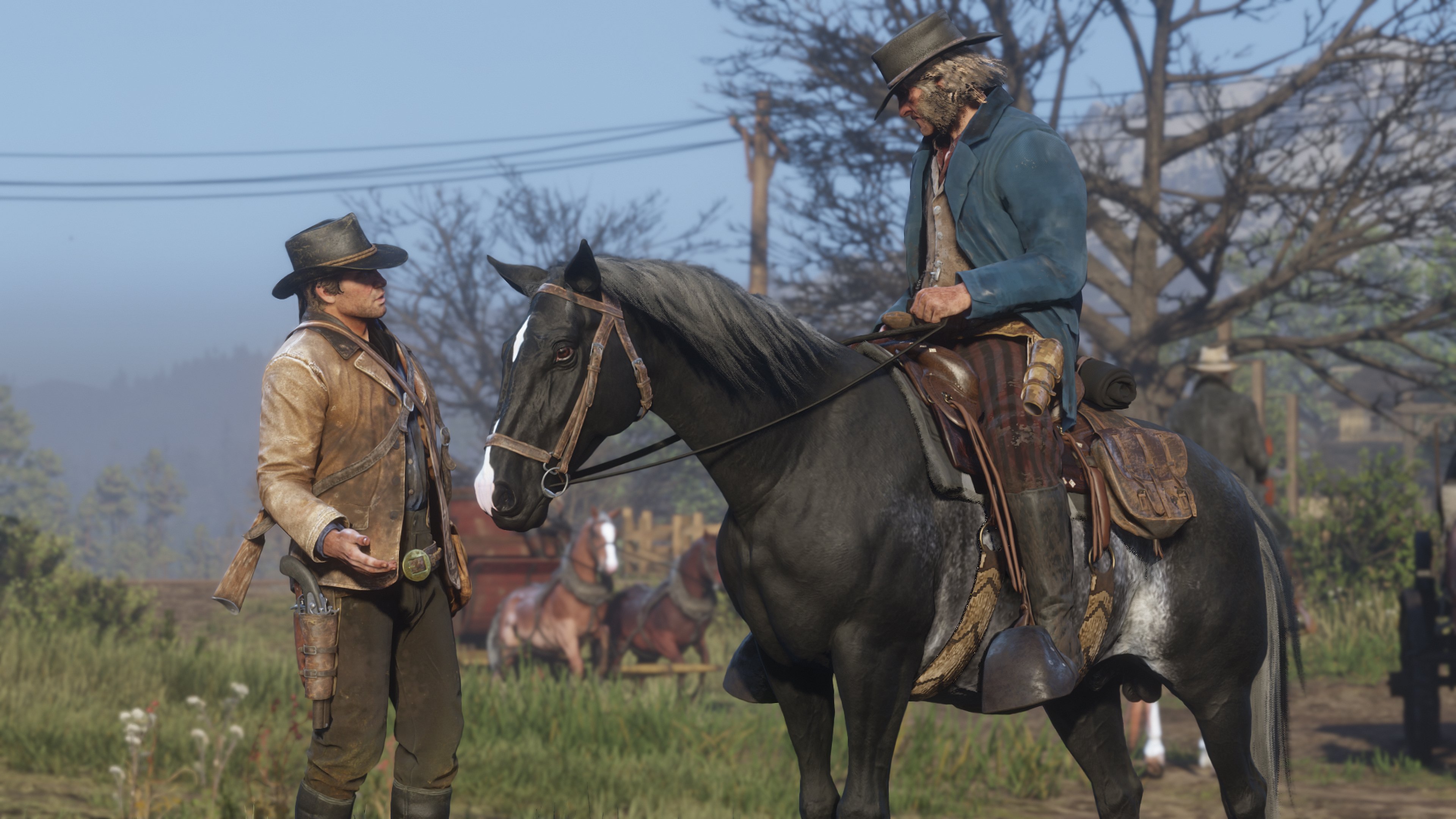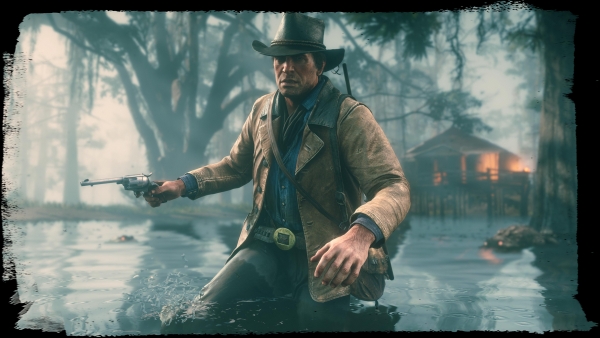
Red Dead Redemption 2 is less than a week away from launch! Sadly, for us PC gamers, the best cowboy simulator since West of Loathing is actually a big question mark away, though, considering the nature of Rockstar’s fantastic PC rendition of GTA V, the wait may well be worth it. With that being said, let’s continue our deep dive into Red Dead Redemption’s underlying tech. Today, we’ll be looking at physics and animation, environments and emergent gameplay, and post-processing.
Physics and Animation:
Physics, particularly character physics has always been a strong point for the RAGE engine. Rockstar took the unusual step of integrating Euphoria physics middleware into the RAGE engine in Grand Theft Auto IV. RAGE and its resultant emergent physics interactions elevated sandbox gameplay in GTA IV from the expected running and gunning into something more: an at-times appallingly realistic simulation of violence. Euphoria was toned down a bit in the next iteration of GTA (although there are mods that let you pull off the classic hand-stuck-in-the-passenger-door trick). We’re glad to note here that Euphoria is definitely making a comeback in Red Dead Redemption 2.
Red Dead Redemption 2’s more refined implementation of Euphoria is easy to see at 2:03 in the second gameplay trailer: Arthur shoots a bounty hunter on horseback and as the bounty hunter falls, he actually extends his hand to try to cling to the horse for a moment: Euphoria uses a biomechanical simulation of characters, tied to their musculoskeletal and nervous systems. This results in emergent animations where characters behave as they might in real life: Knock a guy off his horse and he’ll most likely scramble to hold onto it for a moment longer. As a result, it doesn’t make sense to talk about animations per se, as Red Dead Redemption 2 with Euphoria doesn’t have the kind of canned animations you’d expect. Instead, each physical interaction of a character or characters is informed by an approximation of what they’d do in that situation in real life. At 3:15 in the second gameplay trailer, Euphoria adds additional impact to the rough and tumble of a brawl.
Apart from character animation, improvements to the physics engine are evident elsewhere. For starters, there’s hair physics now! As seen at 4:08 in the first gameplay trailer, the long-haired bandit’s hair flows as he falls. While Hairworks may get some flak for being a proprietary, platform-biased solution, it and TressFX have done much to set expectations for in-game hair rendering. Gone are the hair helmets and purposefully short haircuts of last-gen. Instead, we now have realistic, animated tresses of hair across a variety of titles. Rockstar’s solution, likely in-house, compares favourably, even with titles like Deus Ex: Mankind Divided which explicitly use an implementation of TressFX/Purehair.
Environmental physics also receives a significant upgrade in Red Dead Redemption 2. As mentioned by Rockstar in an IGN interview, you’ll have the ability to burn structures down in the game. This is evident at 0:22 where fire appears to propagate over a small area. Moreover, at 2:20 in the second gameplay trailer, we see Arthur taking on a stagecoach which is then lit on fire. Vehicular destruction has been par for the course in Rockstar games since the earliest 3D-era games. Since stagecoaches have been a recurrent theme in the trailers, we’re confident that you’ll be able to indulge in some 19th century vehicular mayhem.
Environment and Emergent Gameplay
Rockstar is, by way of GTA III, one of the first studios to introduce emergent, 3D sandbox gameplay to wider audiences. Later GTA titles and the first Red Dead Redemption have also done much to turn their sandboxes into laboratories for emergent gameplay. Free of the shackles of previous-generation hardware, Red Dead Redemption 2 clearly aims to take this several steps further.
Wildlife
The hunting system seen at 5:04 in the first gameplay trailer, and wildlife in general are cases in point: Rockstar have themselves stated that wildlife in Red Dead Redemption 2 will function within the bounds of the food chain and act accordingly, towards humans and towards other animals. Scavengers will quickly pick up on carrion and birds will fly in formation, among other details. Rockstar highlighted that over 200 species of animals will be present: such complicated interactions between so many types of animals calls to memory the original promises made about S.T.A.L.K.E.R’s vaunted A-life system, which was initially sophisticated enough that NPCs could theoretically beat the game without player involvement. The large degree of interaction between wildlife and the character and among different species ensures that going off the beaten track will offer a whole range of emergent gameplay possibilities when hunting, including playing one type of animal off the other. The sale of animal pelts and other products, mentioned at 5:06 in the trailer indicate real role-playing possibilities for people whose interests lie outside the confines of the game’s plot.
Atmospherics
Time-of-day plays a key role in both the atmospherics and gameplay of Red Dead Redemption 2. Gameplay in both trailers shows action taking place in both the daytime and at night. Stealth is also likely to play a role, as seen in 1:51 where Arthur hides behind a log cabin as a lawman passes by on horseback. GTA V already featured stealth takedowns. Considering the amount of gameplay lavished on night-time sequences in the Red Dead Redemption 2 trailers, we expect stealth to play a larger role this time around, either in terms of stealth-based missions or as an actual, viable gameplay approach.
Another key atmospheric highlight is Red Dead Redemption 2’s treatment of snow. We’ve seen snow deformation at least as far back as 2012’s Assassin’s Creed III, where it was a novelty on PC. Current-gen hardware, however, has caught up to the point that snow in chilly environs reacts realistically to people and animals, with prints and troughs left in the wake of their passing. Red Dead Redemption 2 also has a great implementation of snow deformation—you can see the snow forming realistic troughs as Arthur trudges through it at 0:29 in the second gameplay video.
Post-processing effects:
We spent some time in the previous feature discussing the various graphical upgrades seen in Red Dead Redemption 2. Today, we’ll go into some detail about the game’s post-processing pipeline. For starters, temporal anti-aliasing seems to be the option of choice: this is evident across gameplay shots as a smooth and stable image is maintained, with coverage extended to transparencies like grass as well. Some degree of artifacting is evident, however, as seen on the outlaw’s hair at 0:11 in the second gameplay trailer. Haze and volumetric lighting play an important role in generating atmosphere. At 0:44, we see dust motes reflect yellow lantern light in the foreground. At 1:15, crepuscular rays combine with volumetric fog to create a distinct sense of early morning. Volumetric clouds also appear to be on the cards, as seen at 1:30. The game utilizes a rather simple depth of field implementation, simply blurring the background, as seen at 1:46. There is also limited use of per-object motion blur: At 2:19, the stagecoach horse’s hooves blur while the rest of the scene remains stable. While neither depth of field nor motion blur is heavy-handed, they contribute to the general cinematic presentation of the game.
Stay tuned here! In the third part of this feature we’ll be discussing possibilities regarding the rumoured (and as-yet unannounced) PC version of the game.



















